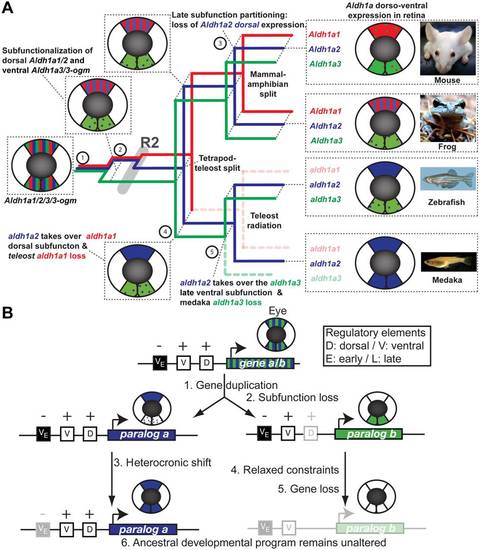FIGURE
Fig. 8
- ID
- ZDB-FIG-130213-5
- Publication
- Caņestro et al., 2009 - Consequences of lineage-specific gene loss on functional evolution of surviving paralogs: ALDH1A and retinoic acid signaling in vertebrate genomes
- Other Figures
- All Figure Page
- Back to All Figure Page
Fig. 8
|
Consequences of lineage-specific gene loss on functional evolution of surviving paralogs. (A) Evolutionary model reconstructing the evolution of Aldh1a gene subfunctions in the developing retina. Mechanisms of early subfunctionalization, late subfunction partitioning, and acquisition or modification of ancestral subfunctions associated to events of gene duplication or gene loss (dotted lines) are indicated in the horizontal plane of a three-dimensional tree, in which events of vertebrate diversification are indicated in the vertical plane. A schematic retina at the stage of complete cup invagination represents dorso ventral (DV) expression domains of Aldh1a genes in different colors is indicated for present species and inferred for ancestral conditions. Bars indicate co-expression in the same dorso-ventral domains (or expression of ancestral genes), and dots refer to weak or remaining expression from earlier developmental stages. Aldh1a1: red, Aldh1a2: blue and Aldh1a3: green. Aldh1a expression data have been obtained from [58], [65], [69], [77], [79], [80], [84]?[87], [111]?[120] and this work Figure 6B). (B) Evolutionary mechanistic model to explain how the ancestral developmental program can remain unaltered after gene loss. This general model, extrapolated from our findings on the evolution of the expression of Aldh1a paralogs during eye development, is based on how heterochronic expression could facilitate the loss of a paralog, while leading to an apparent shuffling of functions between a lost paralog and a surviving paralog without the gain of new regulatory elements, but the loss of negative regulators. |
Expression Data
Expression Detail
Antibody Labeling
Phenotype Data
Phenotype Detail
Acknowledgments
This image is the copyrighted work of the attributed author or publisher, and
ZFIN has permission only to display this image to its users.
Additional permissions should be obtained from the applicable author or publisher of the image.
Full text @ PLoS Genet.

